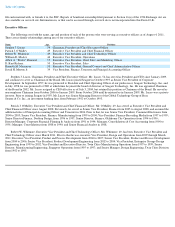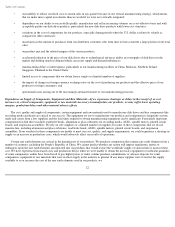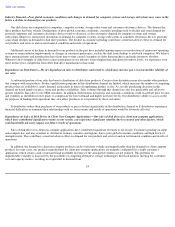Seagate 2010 Annual Report Download - page 27
Download and view the complete annual report
Please find page 27 of the 2010 Seagate annual report below. You can navigate through the pages in the report by either clicking on the pages listed below, or by using the keyword search tool below to find specific information within the annual report.
Table of Contents
Industry Demand
—Poor global economic conditions and changes in demand for computer systems and storage subsystems may cause in the
future a decline in demand for our products.
Our disk drives are components in computers, computer systems, storage subsystems and consumer electronics devices. The demand for
these products has been volatile. During times of poor global economic conditions, consumer spending tends to decline and retail demand for
personal computers and consumer electronics devices tends to decrease, as does enterprise demand for computer systems and storage
subsystems. Moreover, unexpected slowdowns in demand for computer systems, storage subsystems or consumer electronics devices generally
cause sharp declines in demand for disk drive products. The decline in consumer spending could have a material adverse effect on demand for
our products and services and on our financial condition and results of operations.
Additional causes of declines in demand for our products in the past have included announcements or introductions of major new operating
systems or semiconductor improvements or changes in consumer preferences, such as the shift from desktop to notebook computers. We believe
these announcements and introductions have from time to time caused consumers to defer their purchases and made inventory obsolete.
Whenever an oversupply of disk drives causes participants in our industry to have higher than anticipated inventory levels, we experience even
more intense price competition from other disk drive manufacturers than usual.
Dependence on Distributors
—We are dependent on sales to distributors and retailers, which may increase price erosion and the volatility of
our sales.
A substantial portion of our sales has been to distributors of disk drive products. Certain of our distributors may also market other products
that compete with our products. Product qualification programs in this distribution channel are limited, which increases the number of competing
products that are available to satisfy demand, particularly in times of lengthening product cycles. As a result, purchasing decisions in this
channel are based largely on price, terms and product availability. Sales volumes through this channel are also less predictable and subject to
greater volatility than sales to our OEM customers. In addition, deterioration in business and economic conditions could exacerbate price erosion
and volatility as distributors lower prices to compensate for lower demand and higher inventory levels. Our distributors' ability to access credit
for purposes of funding their operations may also affect purchases of our products by these customers.
If distributors reduce their purchases of our products or prices decline significantly in the distribution channel or if distributors experience
financial difficulties or terminate their relationships with us, our revenues and results of operations would be adversely affected.
Dependence on Sales of Disk Drives in Client Non
-Compute Applications—Our sales of disk drives for client non-compute applications,
which have contributed significant revenues to our results, can experience significant volatility due to seasonal and other factors, which
could materially adversely impact our future results of operations.
Sales of disk drives for client non-compute applications have contributed significant revenues to our results. Consumer spending on client
non-compute has, and may continue to, deteriorate in many countries and regions, due to poor global economic conditions and high levels of
unemployment. This could have a material adverse effect on demand for our products and services and on our financial condition and results of
operations.
In addition, the demand for client non-compute products can be even more volatile and unpredictable than the demand for client compute
products. In some cases, our products manufactured for client non-compute applications are uniquely configured for a single customer's
application, which creates a risk of unwanted and unsellable inventory if the anticipated volumes are not realized. This potential for
unpredictable volatility is increased by the possibility of competing alternative storage technologies like flash memory meeting the customers'
cost and capacity metrics, resulting in a rapid shift in demand from
24
























